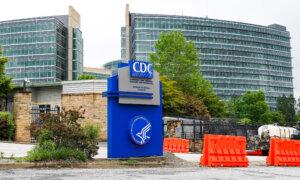Chronic Fatigue Syndrome ‘No More Likely’ After COVID Than Other Infections, CDC Study Finds
Researchers find that chronic fatigue syndrome after COVID-19 is less prevalent than previously thought.
People have the same chance of developing chronic fatigue syndrome after COVID-19 as they do after any other infection, according to a study published Wednesday.
“COVID-19 can trigger ME/CFS (myalgic encephalomyelitis/chronic fatigue syndrome), but there are other infectious diseases that also lead to ME/CFS,” the study’s lead author, Dr. Beth Unger at the U.S. Centers for Disease Control and Prevention (CDC), told The Epoch Times via email.
The new study found that 2–3 percent of people developed ME/CFS symptoms, commonly associated with long COVID, a year after contracting COVID-19. This was similar to the 3–4 percent of people who reported symptoms after falling ill with non-COVID-related illnesses.
ME/CFS is a chronic fatigue condition characterized by a series of symptoms that include chronic fatigue, sleep problems, brain fog, postexertional malaise, and many more.
“While the prevalence rates for ME/CFS-like illness after having had COVID might be considered low, given how many millions of individuals have had COVID-19, this suggests that an extremely large number of individuals might have ME/CFS-like illness,” Dr. Joann Elmore, co-senior author and a professor of medicine in the division of general internal medicine and health services research at the University of California–Los Angeles (UCLA), told The Epoch Times.
Similar Rates of Disease
The study, published in JAMA Network Open, is one of several that suggest the prevalence of ME/CFS after COVID-19 may be lower than previously thought.
The study followed over 4,700 people for up to 12 months, from December 2020 to August 2022.
Some criteria included reduced activity level for over six months, fatigue, unrefreshing sleep, and postexertional malaise.
Of all the participants studied who developed COVID-like symptoms, about half tested positive for COVID-19 and were considered infected.
At three months post-infection, over 3 percent of both COVID-19-positive and COVID-19-negative groups reported experiencing ME/CFS-like illness.
Conflicting Findings?
Previous research has suggested that about 10 percent of people who come down with COVID-19 will develop long COVID, a condition that shares many overlapping characteristics with ME/CFS.
Lauren Wisk, one of the study’s lead co-authors, highlighted that the study’s findings do not contradict prior ones.
“We’re not really commenting specifically on long-COVID prevalence here, but rather, a separate sort of condition that has a really clear clinical criteria for diagnoses,” she told The Epoch Times. “I think there’s probably a lot of overlap between those two groups, but I don’t think that we can really say anything from these prevalence estimates about the prevalence of long COVID.”
She added that the current murky definition of long COVID is a major factor in the difficulty of estimating long COVID prevalence.
The study showed that people who contracted COVID-19 had a 68 percent greater risk of fatigue and a 330 percent greater risk for chronic fatigue than those who did not contract the infection.
Dr. Elmore said that the prior study differs from the new one in that it relied on electronic health records.
Dr. Unger explained the differences similarly, adding that the two studies are not comparable because the prior one only examined rates of fatigue and chronic fatigue symptoms. In contrast, the current study investigated the prevalence of ME/CFS diagnosis following COVID-19.
“It is important to note that ‘fatigue’ and ‘chronic fatigue’ are different from ME/CFS. To be diagnosed with ME/CFS, a person must have an illness that affects multiple body systems … ME/CFS symptoms are much more than just ‘being tired,’ which is what fatigue and even chronic fatigue refer to,” Dr. Unger said.
The authors wrote in their study that ME/CFS may be missed in clinical diagnosis, making electronic health records potentially unreliable. However, they also noted that their research may underestimate the condition’s prevalence in patients who contracted COVID-19, as some may fail to report the right symptoms, and others may test negative for the disease.
Dr. Elmore said she is open to the possibility that future data may contradict their current findings.
“There will likely be variability in future prevalence rates due to differences in study populations and types of data used to define ME/CFS [after COVID-19],” she told The Epoch Times.






